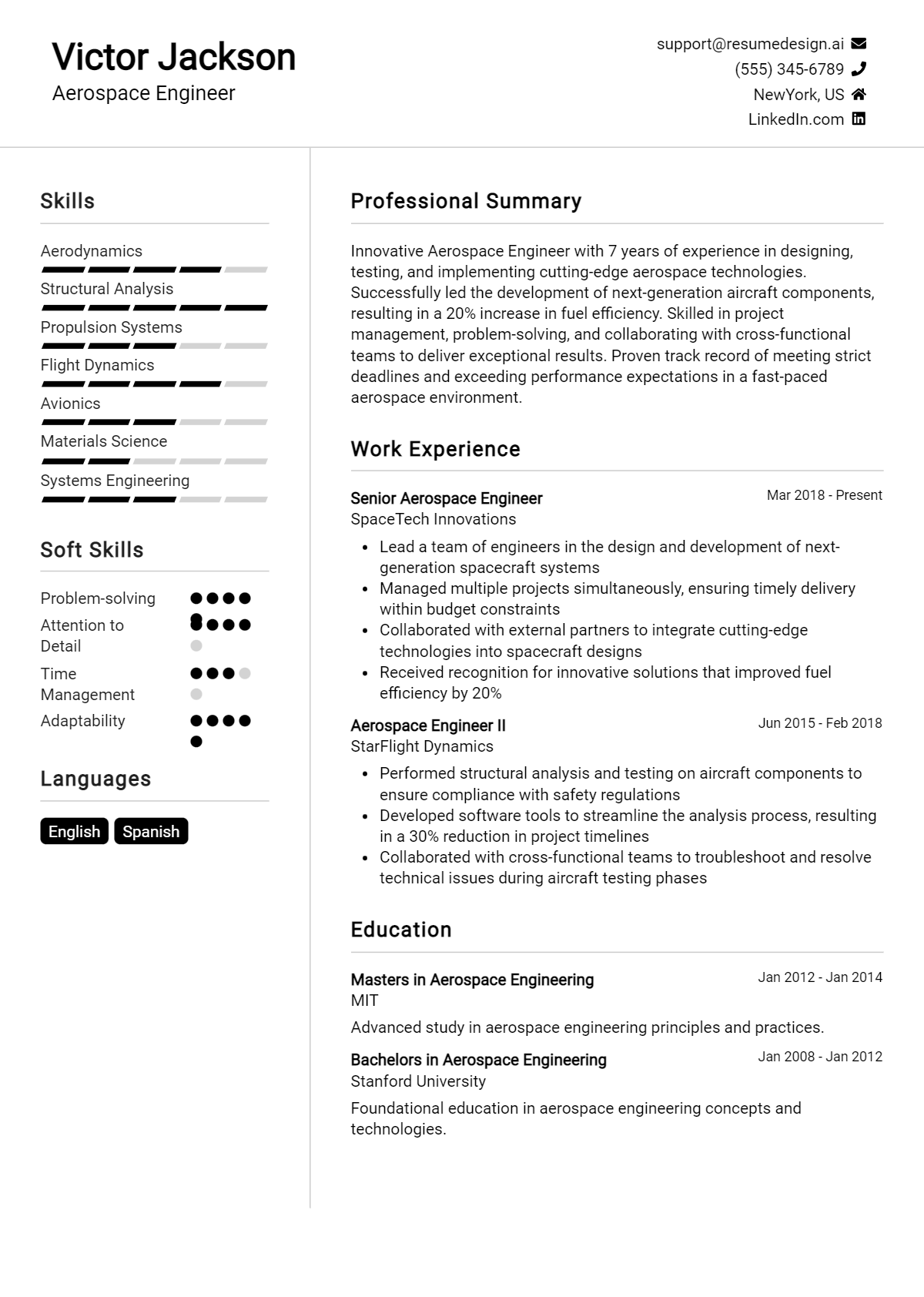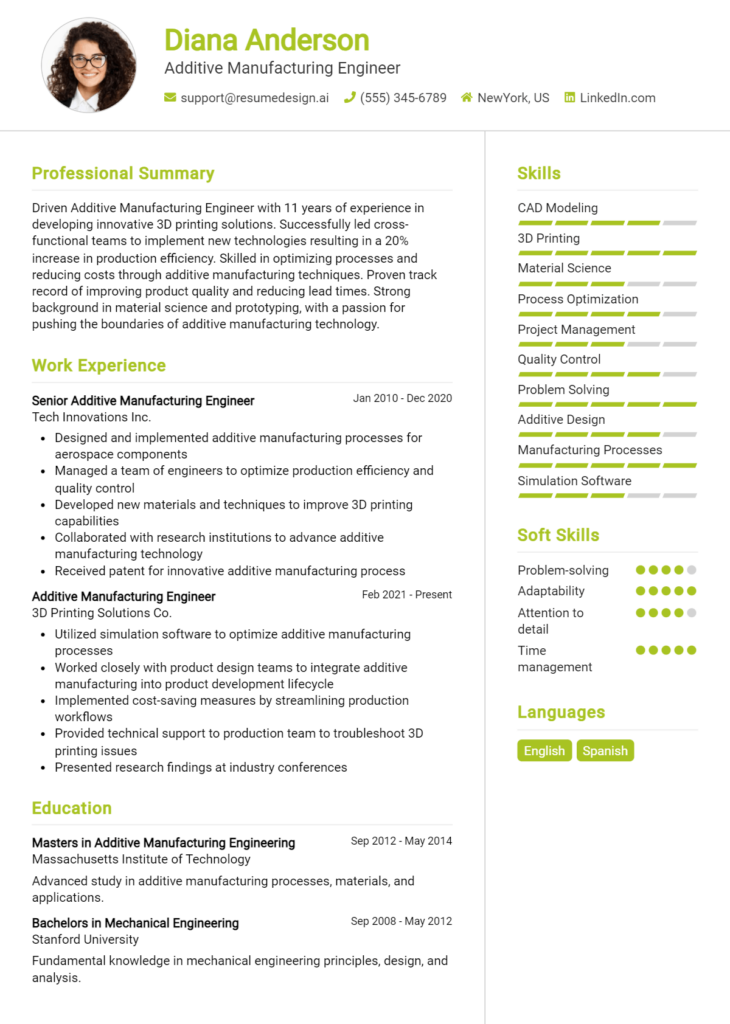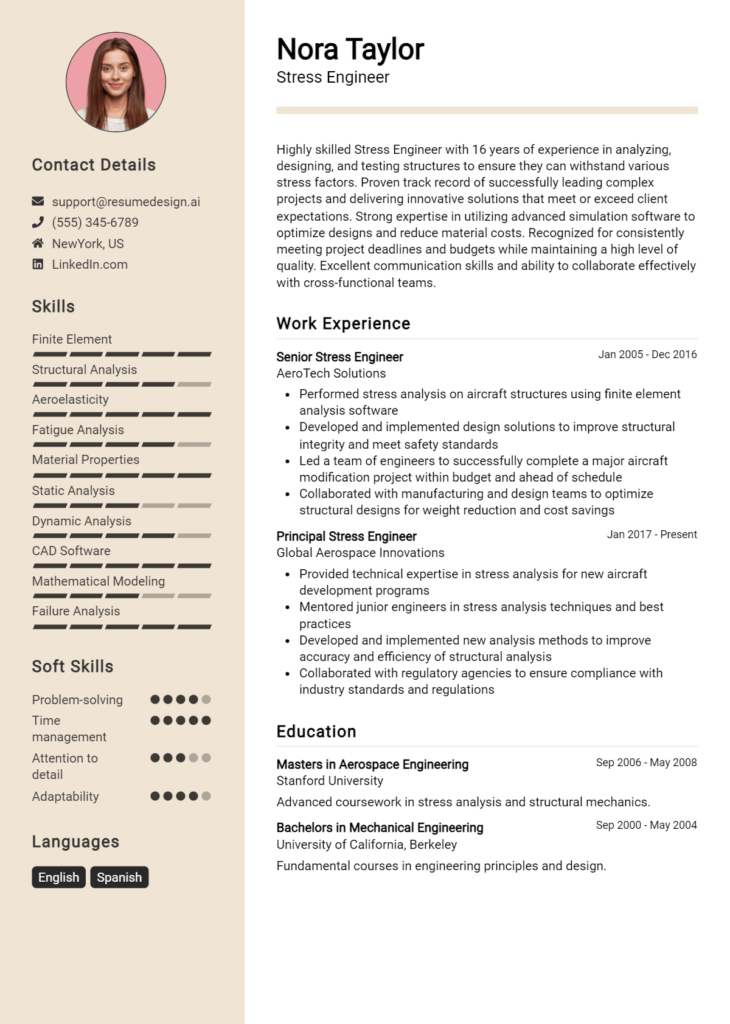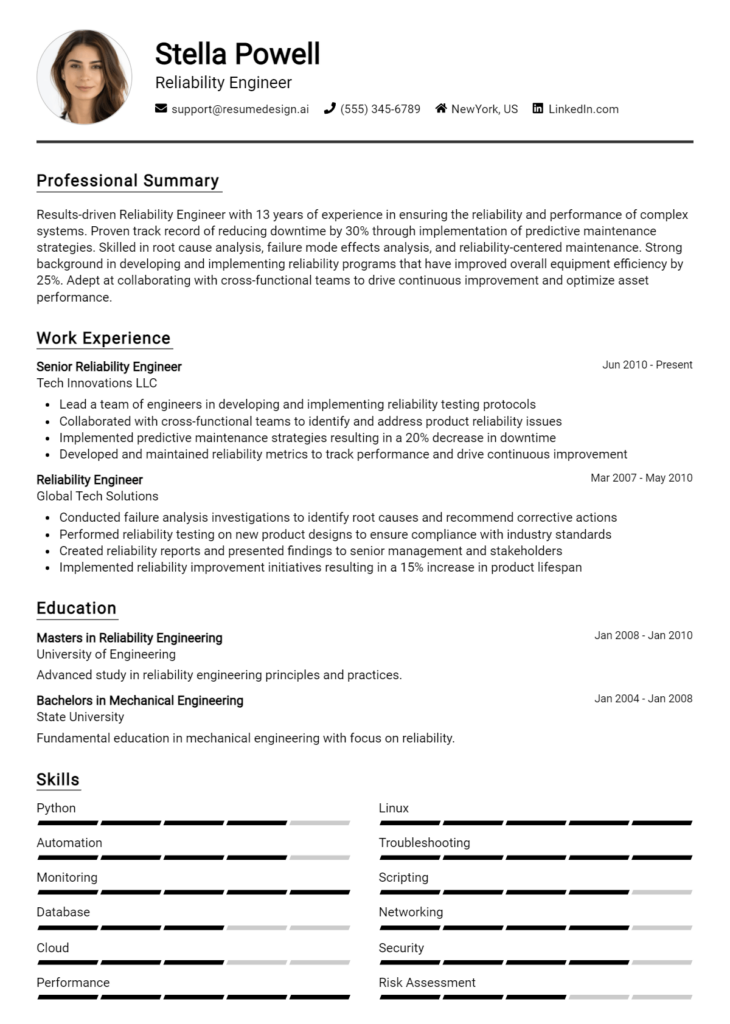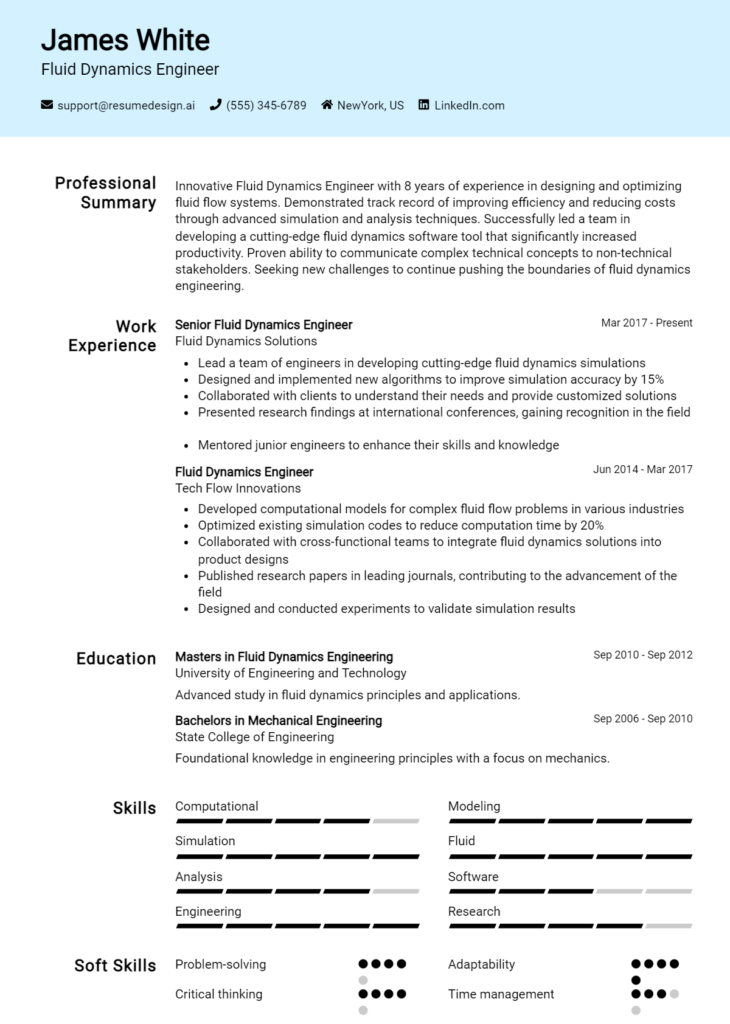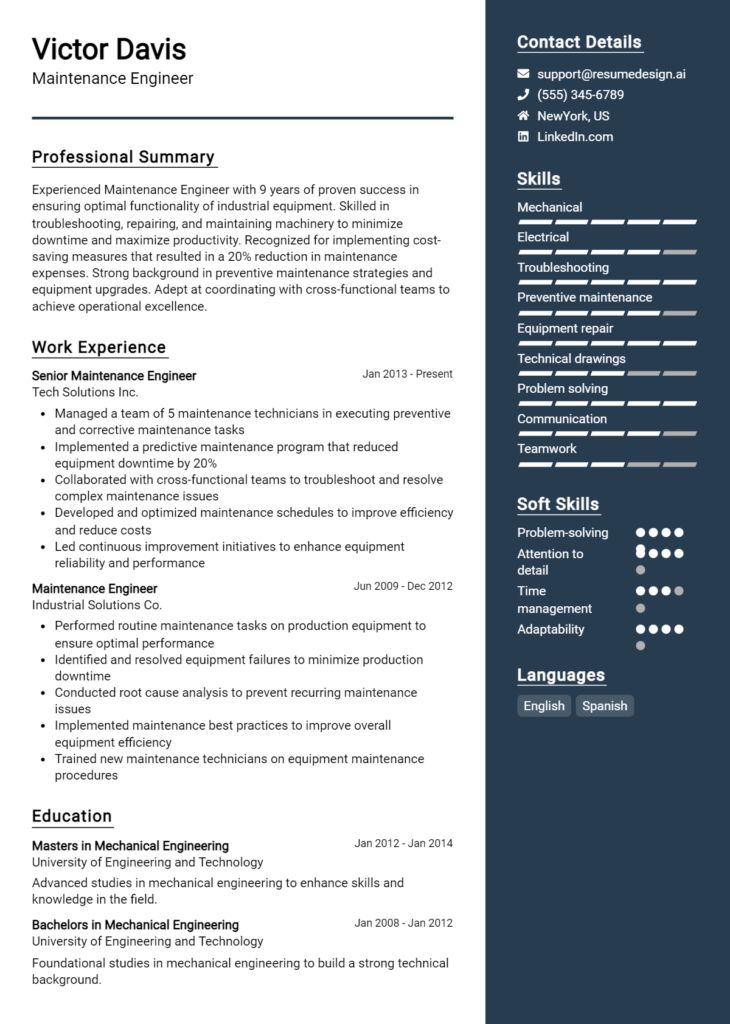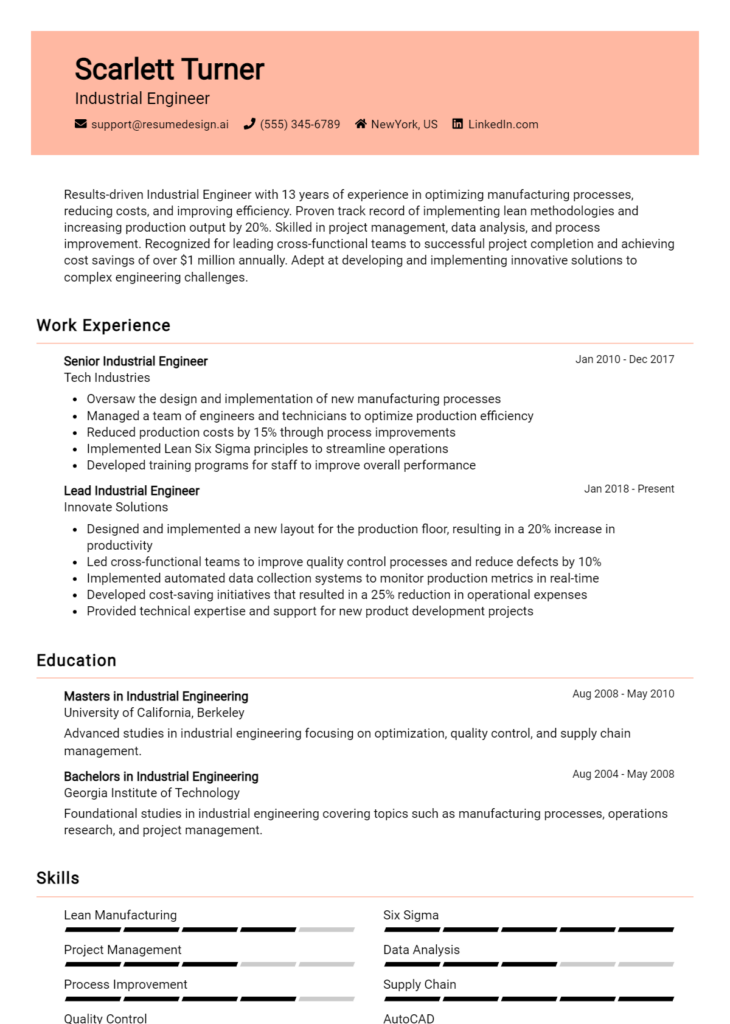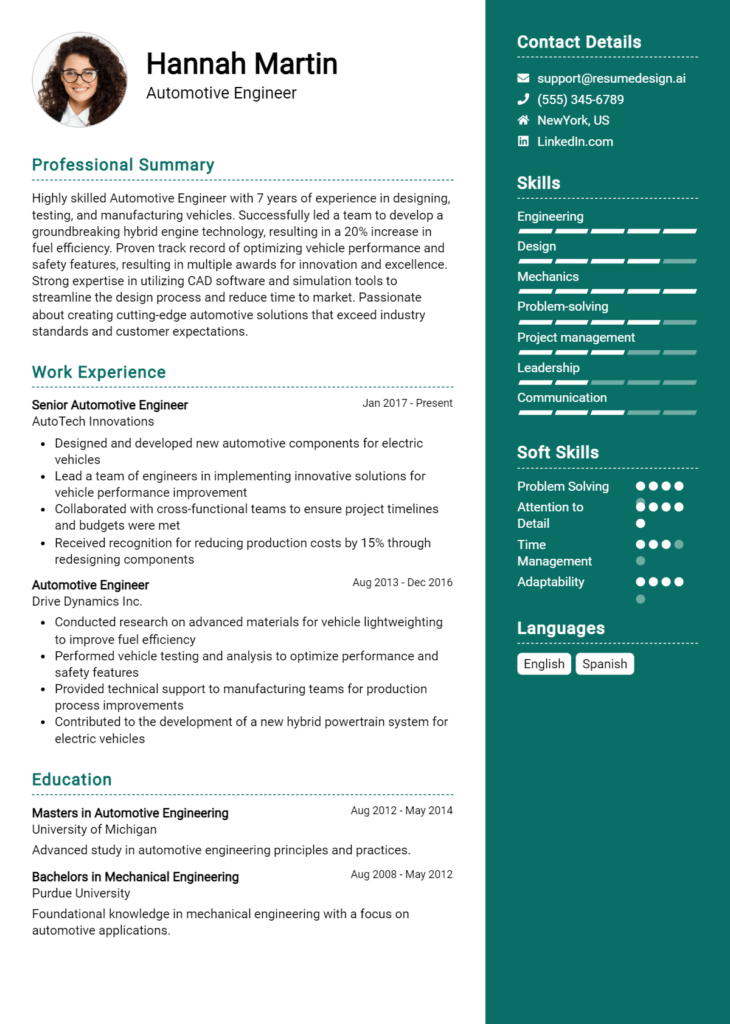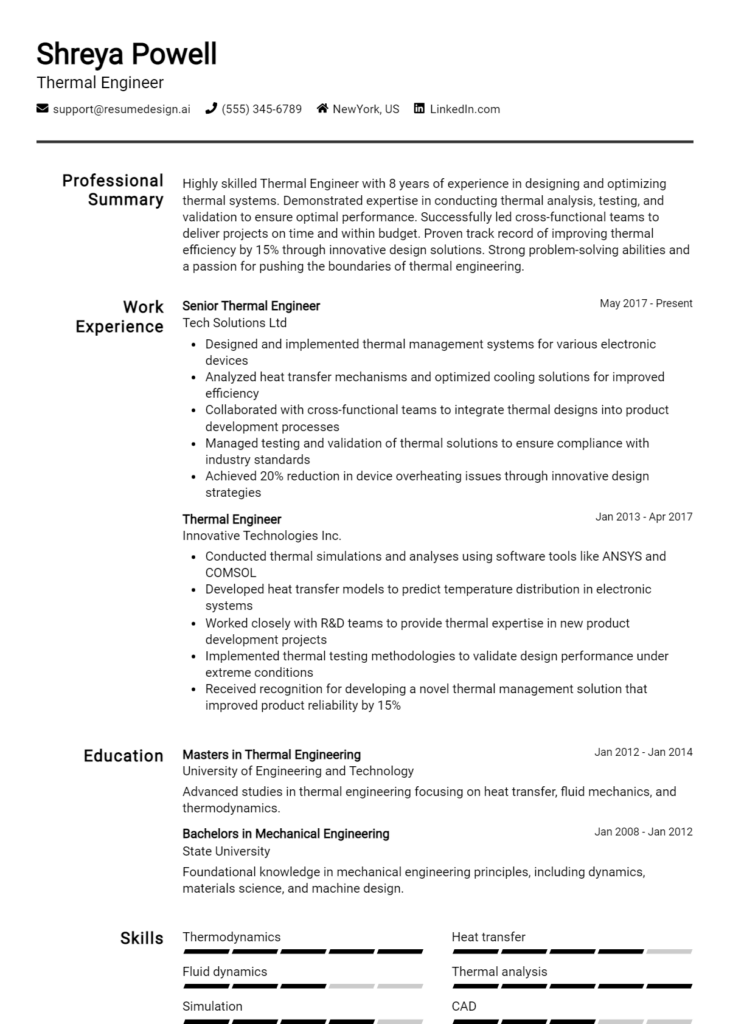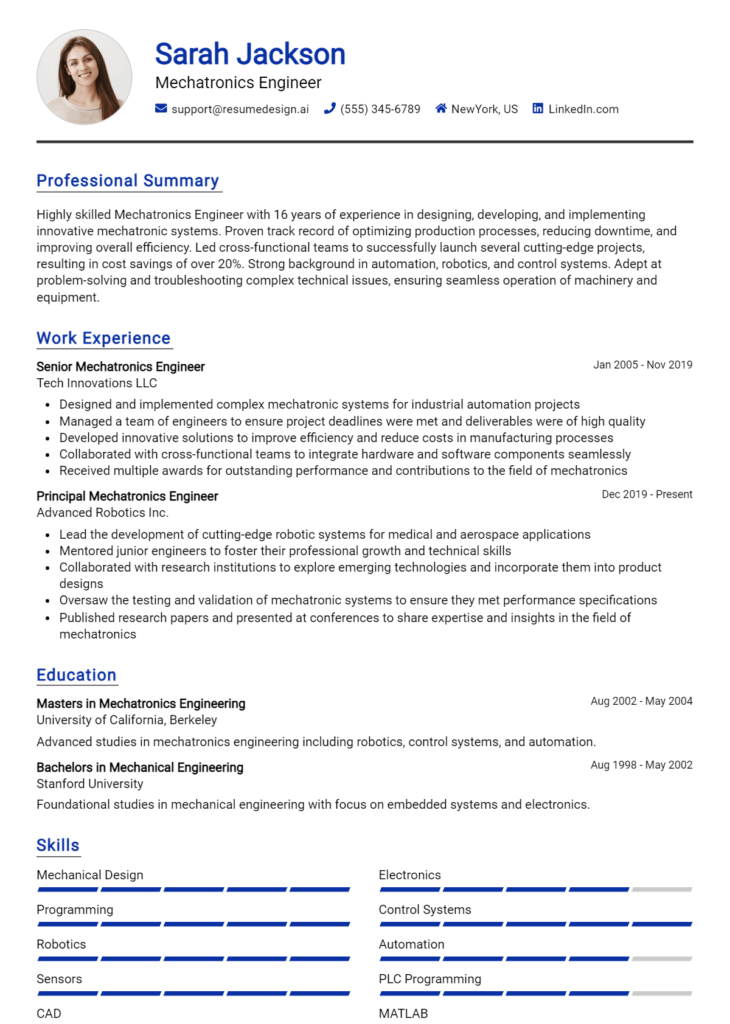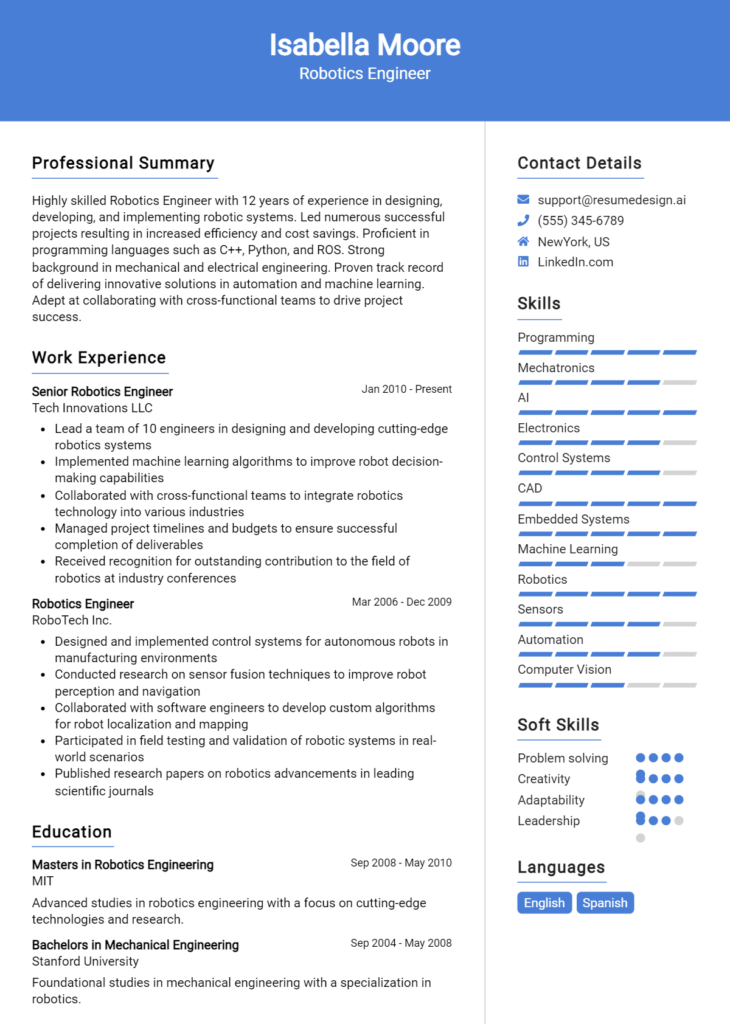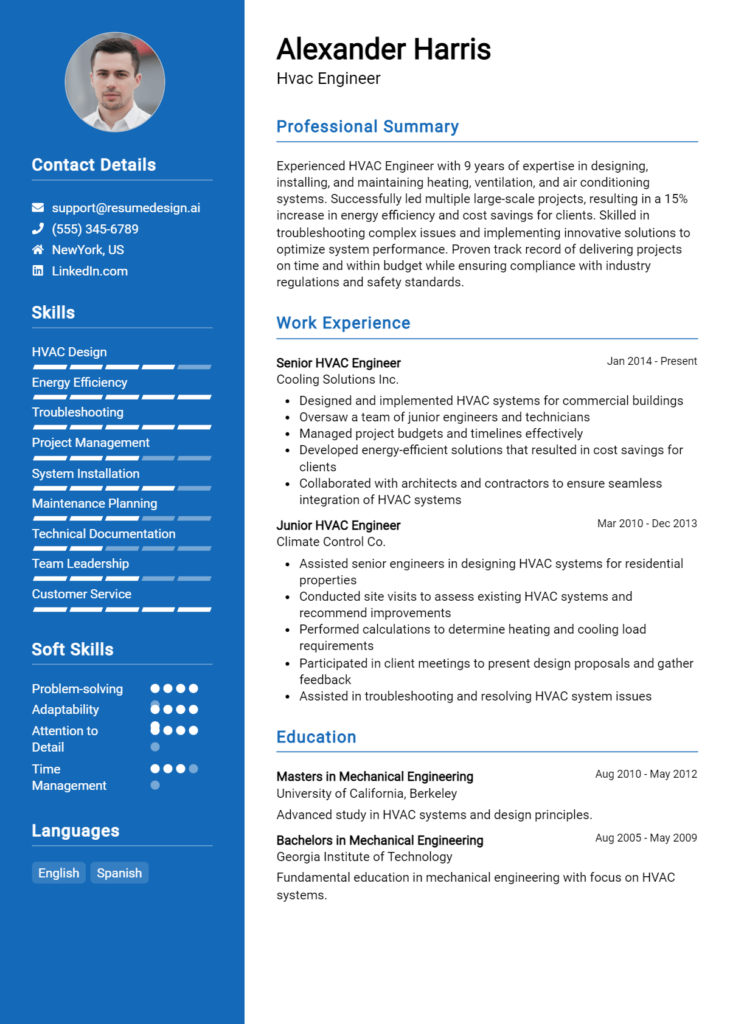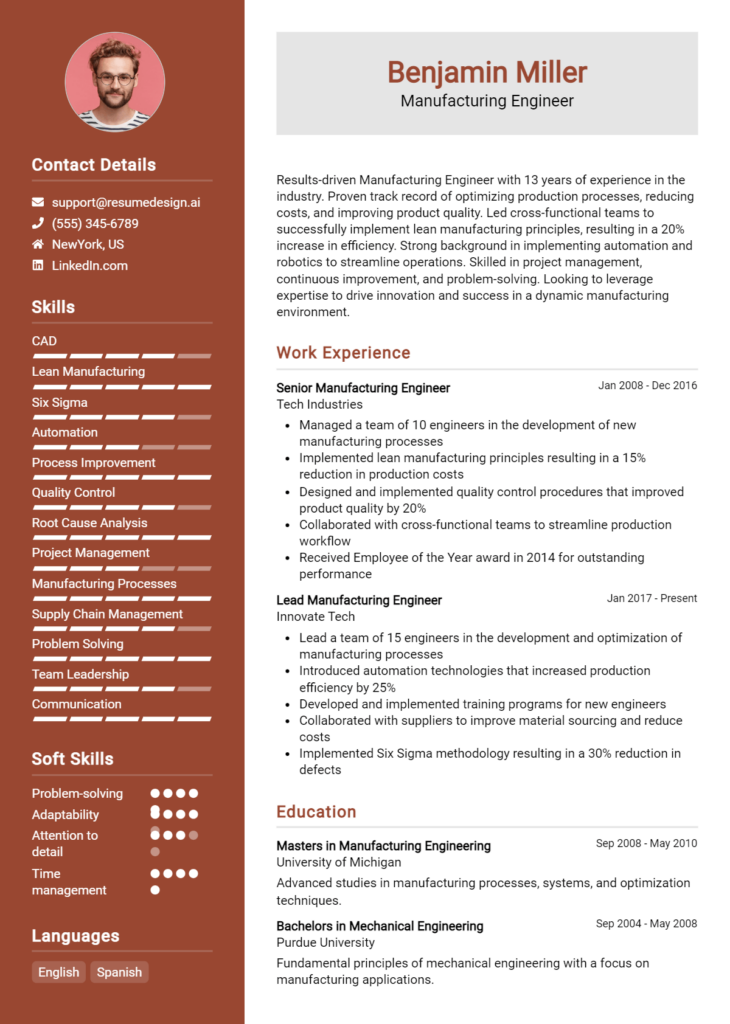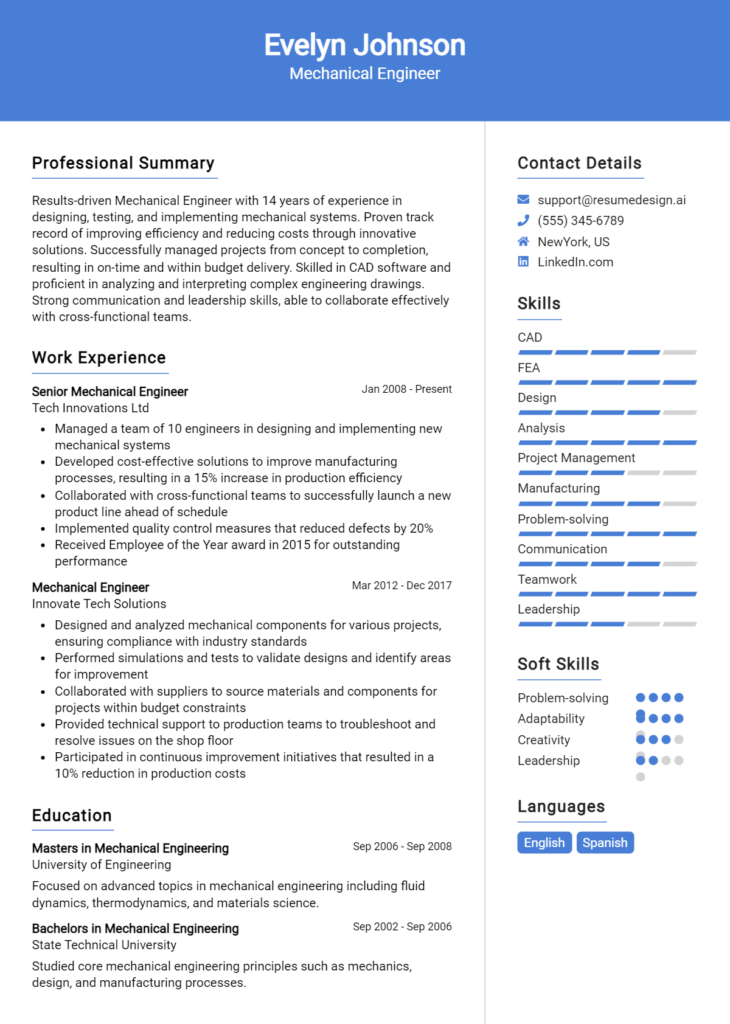Aerospace Engineer Core Responsibilities
Aerospace Engineers play a crucial role in designing, developing, and testing aircraft and spacecraft, requiring a blend of technical expertise, operational knowledge, and strong problem-solving skills. They collaborate across departments, ensuring that engineering, manufacturing, and quality assurance teams work cohesively to meet project goals. Successful Aerospace Engineers leverage analytical skills to troubleshoot design issues, contributing significantly to organizational objectives. A well-crafted resume highlighting these qualifications can effectively demonstrate their capability to drive innovation and efficiency in aerospace projects.
Common Responsibilities Listed on Aerospace Engineer Resume
- Design and analyze aerospace systems and components.
- Conduct simulations and testing to validate design performance.
- Collaborate with multidisciplinary teams to integrate systems.
- Ensure compliance with safety and regulatory standards.
- Develop technical documentation and reports.
- Identify and solve complex engineering problems.
- Manage project timelines and budgets effectively.
- Stay updated on industry trends and emerging technologies.
- Participate in design reviews and provide feedback.
- Support the development of prototypes and models.
- Oversee and coordinate manufacturing processes.
High-Level Resume Tips for Aerospace Engineer Professionals
In the competitive field of aerospace engineering, a well-crafted resume is crucial for making a strong first impression on potential employers. Your resume serves as a personal marketing tool, showcasing not just your technical skills but also your achievements and contributions to previous projects. Given the specialized nature of the aerospace industry, it’s essential that your resume reflects both your expertise and your ability to address the unique challenges of this field. This guide will provide practical and actionable resume tips specifically tailored for aerospace engineer professionals, ensuring that your application stands out in a sea of candidates.
Top Resume Tips for Aerospace Engineer Professionals
- Tailor your resume to the specific job description by incorporating relevant keywords and phrases that match the requirements of the position.
- Highlight your relevant experience in aerospace projects, internships, or research, emphasizing your role and contributions.
- Quantify your achievements by using metrics to demonstrate the impact of your work, such as improvements in efficiency, cost savings, or successful project completions.
- Showcase your technical skills, including proficiency in software tools commonly used in aerospace engineering, such as CAD, MATLAB, and simulation software.
- Include certifications and licenses relevant to the aerospace industry to enhance your credibility and show your commitment to professional development.
- Use clear and concise language, focusing on action verbs to describe your responsibilities and accomplishments.
- Incorporate a section for professional affiliations, such as memberships in organizations like the American Institute of Aeronautics and Astronautics (AIAA).
- Keep your layout clean and professional, ensuring that your resume is easy to read and visually appealing.
- Limit your resume to one page, especially if you have less than 10 years of experience, to maintain focus and clarity.
- Proofread your resume multiple times to eliminate any spelling or grammatical errors, as attention to detail is crucial in aerospace engineering.
By implementing these tips, you can significantly increase your chances of landing a job in the aerospace engineer field. A polished and targeted resume not only highlights your qualifications but also demonstrates your understanding of the industry and your commitment to excellence, making you a more attractive candidate to potential employers.
Why Resume Headlines & Titles are Important for Aerospace Engineer
In the competitive field of aerospace engineering, a well-crafted resume is crucial for standing out among a pool of qualified candidates. Resume headlines and titles serve as the first impression a hiring manager receives of a candidate's qualifications, making it essential for these elements to be engaging and relevant. A strong headline or title can immediately grab the attention of hiring managers by summarizing a candidate's key qualifications and aligning them with the specific job being applied for. It should be concise, impactful, and directly related to the role, setting the tone for the entire resume and encouraging the reader to delve deeper into the candidate's experience and skills.
Best Practices for Crafting Resume Headlines for Aerospace Engineer
- Keep it concise: Aim for one impactful sentence or phrase.
- Be specific: Tailor the headline to the aerospace engineering position you are applying for.
- Highlight key skills: Include relevant technical skills or areas of expertise.
- Incorporate numbers or outcomes: Quantify achievements when possible.
- Use industry-specific terminology: Familiarity with industry jargon shows expertise.
- Focus on your unique value proposition: What sets you apart from other candidates?
- Stay relevant: Ensure the headline aligns with the job description and requirements.
- Use action-oriented language: Use dynamic verbs to convey enthusiasm and proactivity.
Example Resume Headlines for Aerospace Engineer
Strong Resume Headlines
Innovative Aerospace Engineer with 5+ Years of Experience in UAV Development and Flight Testing
Results-Driven Aerospace Engineer Specializing in Structural Analysis and Design Optimization
Certified Aerospace Engineer with Proven Track Record in Project Management and Cross-Functional Team Leadership
Weak Resume Headlines
Aerospace Engineer Looking for Work
Experienced Professional in Engineering
The strong headlines effectively convey specific skills, relevant experience, and unique attributes that align with the aerospace engineering field, immediately capturing the attention of hiring managers. They are tailored to the role, showcasing measurable accomplishments and expertise that differentiate the candidate. In contrast, the weak headlines lack specificity and fail to communicate any unique qualifications or strengths, making them forgettable and less likely to engage the reader's interest.
Writing an Exceptional Aerospace Engineer Resume Summary
In the competitive field of aerospace engineering, a well-crafted resume summary serves as a critical first impression for hiring managers. This brief but impactful section quickly captures attention by showcasing key skills, relevant experience, and notable accomplishments that align with the job role. A strong resume summary distills a candidate's qualifications into a concise statement that highlights their suitability for the position, making it easier for recruiters to assess their potential value to the organization. Tailored specifically to the job description, an effective summary can differentiate a candidate in a crowded applicant pool.
Best Practices for Writing a Aerospace Engineer Resume Summary
- Quantify Achievements: Use numbers and metrics to demonstrate the impact of your work, such as project outcomes or efficiency improvements.
- Focus on Relevant Skills: Highlight technical skills and competencies that are directly related to aerospace engineering and the specific job you’re applying for.
- Tailor for the Job Description: Customize your summary to reflect the requirements and responsibilities outlined in the job posting.
- Keep it Concise: Aim for 2-4 sentences that capture the essence of your experience and qualifications without unnecessary detail.
- Use Action-Oriented Language: Start sentences with strong action verbs to convey a sense of initiative and achievement.
- Highlight Certifications or Education: Mention relevant degrees or certifications that bolster your credentials as an aerospace engineer.
- Showcase Soft Skills: Include key interpersonal skills that are valuable in team-based engineering environments.
- Avoid Jargon: While technical expertise is important, ensure your summary is understandable to a broader audience, including HR professionals.
Example Aerospace Engineer Resume Summaries
Strong Resume Summaries
Results-driven aerospace engineer with over 7 years of experience in designing and testing advanced propulsion systems. Successfully led a team that improved fuel efficiency by 15%, contributing to a $2M annual cost reduction.
Detail-oriented aerospace engineer skilled in CAD software and systems integration, with a proven track record in managing projects from conception through execution. Achieved a 98% on-time delivery rate for all projects over the last three years.
Innovative aerospace engineer with a Master’s degree in Aerospace Engineering and expertise in aerodynamics and structural analysis. Developed a high-performance prototype that increased lift by 20%, enhancing aircraft efficiency.
Dedicated aerospace engineer with comprehensive experience in compliance and quality assurance processes. Spearheaded initiatives that resulted in a 30% decrease in testing time and improved safety standards across multiple projects.
Weak Resume Summaries
Aerospace engineer with experience in various projects looking for a challenging role in a reputable company.
Skilled in engineering and design, I have worked on some aerospace projects and wish to continue my career in this field.
The examples provided illustrate the stark contrast between strong and weak resume summaries. Strong summaries are specific, quantifiable, and tailored to showcase relevant skills and achievements, effectively demonstrating the candidate's value to potential employers. In contrast, weak summaries are vague and generic, lacking the detail and focus necessary to engage hiring managers or convey the applicant's qualifications effectively.
Work Experience Section for Aerospace Engineer Resume
The work experience section of an Aerospace Engineer resume is a critical component that showcases a candidate's technical skills, leadership abilities, and dedication to delivering high-quality products. This section provides potential employers with insight into the candidate's hands-on experience in the aerospace industry, demonstrating their proficiency in relevant technologies, methodologies, and project management. By quantifying achievements and aligning work experience with industry standards, candidates can effectively communicate their value and stand out in a competitive job market.
Best Practices for Aerospace Engineer Work Experience
- Highlight specific technical skills relevant to aerospace engineering.
- Use quantifiable results to demonstrate the impact of your work.
- Include details about team collaboration and leadership roles.
- Align your experiences with industry standards and best practices.
- Utilize action verbs to convey your contributions effectively.
- Tailor your experience to match the job description and requirements.
- Showcase involvement in projects that led to innovations or improvements.
- Provide context for your roles, emphasizing challenges and solutions.
Example Work Experiences for Aerospace Engineer
Strong Experiences
- Led a cross-functional team in the successful design and testing of a new propulsion system, resulting in a 20% increase in fuel efficiency.
- Managed a project that reduced manufacturing costs by 15% through process optimization and implementation of lean manufacturing techniques.
- Developed and executed a comprehensive testing protocol for a satellite system, achieving a 98% success rate in performance metrics.
- Collaborated with software engineers to create a flight simulation model that improved pilot training efficiency by 30%.
Weak Experiences
- Worked on various engineering projects.
- Assisted with the design of aircraft components.
- Participated in team meetings and discussions.
- Helped with testing processes and documentation.
The examples provided illustrate the difference between strong and weak experiences in an Aerospace Engineer resume. Strong experiences highlight specific achievements, quantifiable results, and leadership roles that demonstrate technical expertise and collaboration. In contrast, weak experiences lack detail and measurable impact, making it difficult for employers to assess the candidate's contributions and capabilities effectively.
Education and Certifications Section for Aerospace Engineer Resume
The education and certifications section of an Aerospace Engineer resume is crucial as it showcases the candidate's academic achievements, industry-relevant credentials, and commitment to ongoing professional development. This section serves as a testament to the engineer's foundational knowledge in aerospace principles, as well as their dedication to staying updated with the latest technologies and methodologies in the field. By including relevant coursework, specialized training, and recognized certifications, candidates can significantly enhance their credibility and demonstrate their alignment with the specific requirements of the aerospace engineering profession.
Best Practices for Aerospace Engineer Education and Certifications
- Include your highest degree first, followed by relevant certifications and specialized training.
- Use clear and concise formatting to enhance readability.
- Highlight industry-recognized certifications such as the Fundamentals of Engineering (FE) or Professional Engineer (PE) licenses.
- Detail relevant coursework that directly relates to aerospace engineering, such as fluid mechanics, thermodynamics, or materials science.
- Indicate the institution's name and graduation date for each degree or certification.
- Consider adding honors or awards received during your education to demonstrate excellence.
- Update this section regularly to reflect any new qualifications or ongoing education.
- Tailor the content to match the requirements of the job description you are applying for.
Example Education and Certifications for Aerospace Engineer
Strong Examples
- M.S. in Aerospace Engineering, Massachusetts Institute of Technology, 2021
- Fundamentals of Engineering (FE) Certification, National Council of Examiners for Engineering and Surveying, 2020
- Coursework: Advanced Fluid Dynamics, Structural Analysis, and Aerospace Materials
- UAV Pilot Certification, Remote Pilot Certificate, Federal Aviation Administration, 2022
Weak Examples
- Bachelor of Arts in History, University of California, 2018
- Certification in Microsoft Office Suite, 2019
- Coursework: Introduction to Psychology
- Old certification in Computer-Aided Design (CAD) from a non-accredited institution, 2017
The strong examples are considered effective because they directly relate to the aerospace engineering field, showcasing advanced degrees and certifications that enhance the candidate's qualifications. They demonstrate relevant technical knowledge and skills that align with industry standards. In contrast, the weak examples showcase degrees and certifications that lack relevance to aerospace engineering, illustrating a disconnect from the required qualifications for the role. This can detract from the candidate's overall appeal to potential employers in the aerospace sector.
Top Skills & Keywords for Aerospace Engineer Resume
In the highly specialized field of aerospace engineering, the skills highlighted in your resume can significantly influence your career trajectory. Relevant skills not only showcase your technical capabilities but also demonstrate your ability to contribute to complex projects, collaborate with diverse teams, and innovate within the industry. A well-crafted resume that emphasizes both hard and soft skills can set you apart from other candidates, making it essential to curate a list that reflects your expertise and aligns with the expectations of potential employers. To ensure your resume stands out, consider the following essential skills that should be included.
Top Hard & Soft Skills for Aerospace Engineer
Soft Skills
- Problem-solving
- Critical thinking
- Team collaboration
- Communication skills
- Adaptability
- Attention to detail
- Leadership abilities
- Creativity
- Time management
- Project management
Hard Skills
- CAD software proficiency (e.g., AutoCAD, SolidWorks)
- Aerospace systems knowledge
- Structural analysis
- Materials science
- Flight dynamics
- Simulation tools (e.g., MATLAB, Simulink)
- Proficiency in programming languages (e.g., Python, C++)
- Knowledge of aerodynamics
- Compliance with safety regulations
- Data analysis and modeling
By focusing on these skills, you can craft a compelling resume that effectively highlights your qualifications. Additionally, it’s important to provide a detailed account of your work experience that demonstrates how you have applied these skills in real-world scenarios.
Stand Out with a Winning Aerospace Engineer Cover Letter
Dear Hiring Manager,
I am writing to express my enthusiasm for the Aerospace Engineer position at [Company Name], as advertised on [Job Portal]. With a Master’s degree in Aerospace Engineering from [University Name] and over five years of hands-on experience in aircraft design and systems integration, I am excited about the opportunity to contribute to your team and further innovate in the aerospace industry. My background in both research and practical applications has equipped me with a comprehensive understanding of aerodynamics, propulsion, and structural analysis, which I believe aligns perfectly with the requirements of this role.
In my previous position at [Previous Company Name], I played a pivotal role in a successful project that involved the development of a next-generation unmanned aerial vehicle (UAV). My responsibilities included conducting detailed simulations, performing wind tunnel testing, and collaborating with cross-functional teams to ensure all specifications were met. This experience honed my problem-solving abilities and strengthened my project management skills, allowing me to effectively coordinate tasks and communicate with team members from diverse engineering disciplines. I take pride in my attention to detail and my commitment to adhering to safety and quality standards throughout the engineering process.
I am particularly drawn to [Company Name] because of its commitment to innovation and sustainability in aerospace technology. I admire your recent initiatives, such as [specific project or initiative], which demonstrate a forward-thinking approach to solving some of the industry's most pressing challenges. I am eager to bring my expertise in computer-aided design (CAD), finite element analysis (FEA), and collaborative teamwork to your company, contributing to groundbreaking projects that push the boundaries of aerospace engineering.
Thank you for considering my application. I look forward to the possibility of discussing how my background, skills, and enthusiasms align with the goals of [Company Name]. I am excited about the opportunity to contribute to your team and help shape the future of aerospace technology.
Sincerely,
[Your Name]
[Your Phone Number]
[Your Email Address]
Common Mistakes to Avoid in a Aerospace Engineer Resume
When crafting a resume for an aerospace engineering position, it’s crucial to present your qualifications effectively. Many candidates overlook essential aspects, leading to common mistakes that can diminish their chances of landing an interview. Understanding these pitfalls can help you create a compelling resume that showcases your skills and experience. Below are some common mistakes to avoid:
Generic Objective Statements: Using a vague or generic objective that doesn’t align with the specific aerospace engineering role can make your resume less impactful. Tailor your objective to reflect your goals and how they relate to the position.
Overloading Technical Jargon: While it’s important to demonstrate your technical knowledge, using excessive jargon can alienate hiring managers who may not have the same level of expertise. Strive for clarity and ensure that your skills are understandable to a broader audience.
Neglecting Relevant Experience: Failing to highlight relevant projects or internships in aerospace can lead to missed opportunities. Make sure to detail your experience in areas like aerodynamics, propulsion systems, or materials science that directly relate to the job.
Poor Formatting: A cluttered or poorly formatted resume can distract from your qualifications. Use clear headings, bullet points, and consistent font styles to improve readability and present a professional appearance.
Ignoring Quantifiable Achievements: Simply listing responsibilities without quantifying your achievements can weaken your impact. Make sure to include specific accomplishments, such as “improved fuel efficiency by 15%” or “led a team of 5 in the design of a new UAV prototype.”
Not Tailoring Your Resume: Sending out a one-size-fits-all resume is a missed opportunity. Customize your resume for each application by incorporating keywords from the job description and emphasizing the most relevant experiences.
Skipping Soft Skills: Aerospace engineers often work in teams and must communicate complex ideas effectively. Ignoring to mention soft skills like teamwork, communication, and problem-solving can create an incomplete picture of your capabilities.
Focusing on Duties Instead of Skills: Listing tasks without demonstrating how they relate to your skill set can diminish the effectiveness of your resume. Instead, focus on the skills you developed and how they apply to the aerospace engineering role you seek.
By avoiding these common mistakes, you can create a more effective resume that highlights your qualifications and increases your chances of landing a desired position in the aerospace engineering field.
Conclusion
As we wrap up our discussion on the vital role of an Aerospace Engineer, it's essential to emphasize the significance of a well-crafted resume that showcases your unique skills and experiences. Aerospace Engineers are at the forefront of innovation, working on projects that can range from designing aircraft to developing spacecraft, and your resume should reflect your expertise in these areas.
Key points to keep in mind when updating your resume include:
- Highlighting your technical skills, such as proficiency in CAD software, knowledge of aerodynamics, and experience with materials science.
- Including relevant project experience, whether in academic settings, internships, or professional roles, to demonstrate your hands-on capabilities.
- Emphasizing certifications or licenses, as they can set you apart in a competitive job market.
- Tailoring your resume for specific job applications, ensuring that it aligns with the requirements of the position you desire.
Now is the perfect time to review and enhance your Aerospace Engineer resume. Utilize available resources to ensure your application stands out. Explore resume templates for a professional layout, try out the resume builder for a user-friendly experience, check out resume examples for inspiration, and don’t forget to craft an impactful cover letter using cover letter templates. Take action today to elevate your career in aerospace engineering!

